Physical Address
304 North Cardinal St.
Dorchester Center, MA 02124
Ependyma and choroid plexus play critical structural and biologic functions within the central nervous system (CNS); the neoplasms that recapitulate these cell types are the most common intraventricular and intramedullary spinal cord tumors. This chapter covers the various categories of ependymal and choroid plexus neoplasms and presents a practical approach to differentiating these tumors from possible diagnostic mimics in both adult and pediatric patients. Special attention is given to ancillary techniques that are useful in diagnostically challenging cases, as well as to controversial issues of histologic grading.
Ependymomas represent a group of gliomas with morphologic and ultrastructural evidence of predominantly or exclusively ependymal differentiation, as opposed to a growing list of tumors with only partial or limited ependymal features. The latter include astroblastoma, chordoid glioma, papillary tumor of the pineal region, pilomyxoid astrocytoma, and angiocentric glioma. The 2016 World Health Organization (WHO) classification scheme recognizes the following ependymal tumor categories: subependymoma (WHO grade I), myxopapillary ependymoma (WHO grade I), ependymoma (WHO grade II) including a number of variants, and anaplastic ependymoma (WHO grade III). In addition, ependymoma, RELA fusion positive, is a newly recognized aggressive entity that includes the majority of supratentorial ependymomas occurring in children and young adults. The previous category of “ependymoblastoma” is now mostly incorporated into the new diagnosis of embryonal tumor with multilayered rosettes, either with or without C19MC alteration, although ependymoblastic rosettes can also be seen occasionally in other embryonal tumor subtypes, such as atypical teratoid/rhabdoid tumor (see Chapter 12 ). Intraventricular neoplasms recapitulating choroid plexus epithelium include choroid plexus papilloma (WHO grade I), atypical choroid plexus papilloma (WHO grade II), and choroid plexus carcinoma (WHO grade III).
Dating back to early perspectives, our concepts of ependymoma histogenesis have been related to embryology and the stages of normal ependymal cell development. This “stem cell” or “progenitor cell” theory of tumorigenesis proposes that radial glia, the multipotent neuroglial progenitor cells, give rise to multiple different populations of elongate unipolar and bipolar cells termed tanycytes; fetal ependymal tanycytes directly give rise to mature ependymocytes, whereas the more highly specialized cells of the circumventricular organs and choroid plexus are ultimately derived from this same developmental pathway. Choroid plexus tumors and ependymomas (including the various histologic subtypes) clearly recapitulate specific cell types found at various stages in this ontologic sequence.
In more recent years, our focus relative to the accurate classification of ependymomas and choroid plexus tumors has shifted from one centered primarily upon development of objective histologic criteria to one that takes advantage of high-resolution genetic and epigenetic classifiers. A number of prognostically relevant molecular “signatures” have been uncovered, as have potential therapeutic targets; these will be explored later in this chapter. It should come as no surprise that the most recent WHO revision emphasizes a combined histologic/molecular approach to tumor classification, with the inclusion of new molecularly defined entities such as RELA fusion-positive ependymoma. It is quite likely that subsequent tumor classifications will markedly expand upon this theme. Despite these triumphs, the concepts of atypical choroid plexus papilloma and ependymoma grading (including the issue of focal anaplasia) remain unresolved and await further clarification.
Ependymomas represent slightly less than 10% of all neuroepithelial tumors; they are the most common primary tumor of the spinal cord and the third most common pediatric CNS tumor, accounting for up to 30% of intracranial tumors in children younger than 3 years of age. They display a bimodal age distribution, with peak incidences at ages 6 and 30 to 40 years, respectively. The vast majority of pediatric ependymomas arise intracranially, but more than 60% of adult ependymomas are centered in the spinal cord. Ependymomas have an equal gender distribution, though they are nearly twice as common in Caucasians as in African Americans. Though most are sporadic, they may also be seen as part of neurofibromatosis type 2, nearly all with cervical spinal localization (see Chapter 22 ). Subependymomas are often incidental autopsy findings in the brains of older adults and represent approximately 10% of all ependymal tumors. They are uncommon in children. In contradistinction, anaplastic ependymomas are far more frequent in the pediatric age group. Arising predominantly in adults, only 10% to 20% of myxopapillary ependymomas manifest in children. They show a 2 : 1 male–female bias.
Accumulating data suggest that despite the histopathologic similarities, supratentorial, posterior fossa, and spinal ependymomas are biologically and genetically distinct entities. In children, the most common site of involvement (predominantly WHO grade II and III categories) is the posterior fossa/fourth ventricle followed by supratentorial location, the latter showing an equal mix of primarily paraventricular and intraparenchymal tumors. Supratentorial tumors (including ependymomas and subependymomas) more frequently involve paraventricular tissues of the lateral ventricles than the third ventricle. Intracranial ependymomas often become symptomatic when their growth results in blockage of cerebrospinal fluid (CSF) pathways, causing signs and symptoms related to hydrocephalus and increased intracranial pressure. These include ataxia, headache, nausea and vomiting, strabismus, irritability, and altered mental status; macrocephaly and bulging fontanels may be encountered in affected infants. Clinical signs and symptoms of anaplastic ependymoma are similar to those of low-grade ependymoma, although they tend to develop in an accelerated fashion.
As noted, a subset of supratentorial ependymomas will entirely lack ventricular involvement, being instead centered within the subcortical white matter or superficial cortex, or rarely at various intracranial extra-axial locations. Of note, superficial cortical ependymomas typically occur in young adults and are typically associated with seizures; mixed histologic features have been described in some, including features reminiscent of angiocentric glioma, schwannian-like nodules, and variant morphologies including clear cell, tanycytic, myxopapillary, giant cell, and anaplastic ependymoma.
Ependymal tumors may arise at any level of the spinal cord, though certain histologic subtypes have preferred locations. For example, conventional ependymomas, including the tanycytic variant, typically manifest as central intramedullary tumors within the thoracic/cervicothoracic region, whereas subependymomas more often arise within the cervical cord in an eccentric fashion. Spinal ependymomas are only rarely anaplastic. Myxopapillary ependymomas invariably arise in the region of the filum terminale; infrequent sites of origin include other spinal cord levels, intracranial sites (both intraventricular and intraparenchymal), and subcutaneous sacrococcygeal areas. As opposed to the typically benign behavior of intradural myxopapillary ependymomas, the soft tissue variant has a relatively high incidence of systemic metastases. Any of the spinal ependymal tumors may cause back pain and motor or sensory deficits, depending on their specific anatomic involvement. Rare extraneural sites for ependymomas include the ovaries, mediastinum, and sacrococcygeum.
Ependymomas and anaplastic ependymomas occasionally metastasize via subarachnoid spread to seed other spinal and intracranial locations; rare extracranial metastases have also been reported. Pediatric myxopapillary ependymomas more often disseminate through the CSF pathways, a feature not typical of the adult counterpart. Although they uncommonly recur, pure subependymomas do not otherwise show metastatic potential.
Conventional ependymomas commonly involve several contiguous spinal segments (three, on average) and grow as sausage-shaped centrally situated intramedullary tumors with discreet margins. The majority are hyperdense by computer tomography (CT) and isointense to hypointense on T1-weighted but hyperintense on T2-weighted magnetic resonance imaging (MRI), with uniform contrast enhancement; rostral and caudal cysts (“syringomyelia”) are frequently encountered ( Fig. 8.1A ). Intracranial tumors are also sharply demarcated. Those in the posterior fossa typically arise within or near the fourth ventricle, with somewhat more variable and heterogeneous contrast enhancement, occasionally with cystic components. These neoplasms commonly extend through the fourth ventricular foramina into the basal cisterns. Intratumoral hemorrhage or calcifications (or both) are also quite common, and obstructive hydrocephalus is frequently encountered ( Fig. 8.1B ). Supratentorial examples are more often cystic and may not be associated with a nearby ventricle ( Fig. 8.1C ).
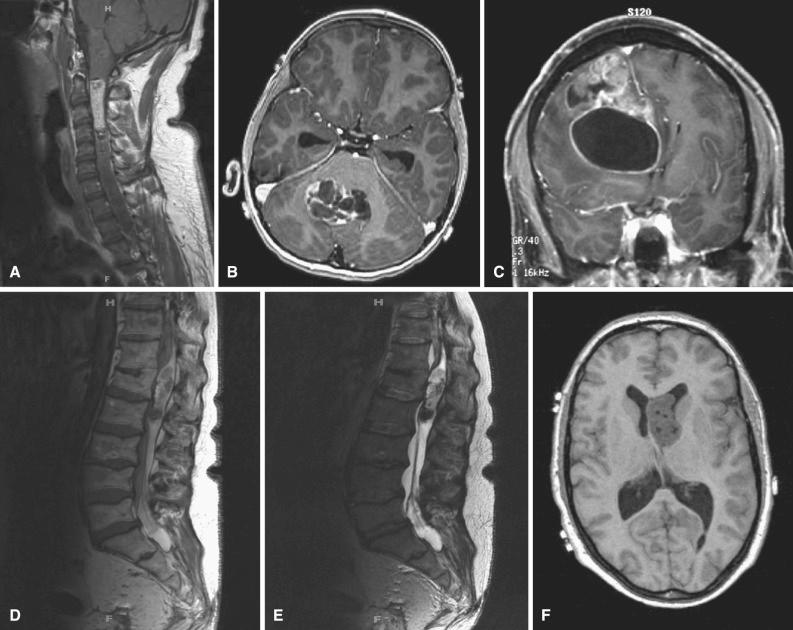
As noted, myxopapillary ependymomas are characteristically well-circumscribed lesions arising in the conus medullaris/cauda equina/ filum terminale region. Unlike conventional ependymomas, the majority of these lesions are hyperintense on T1-weighted MRI due to their mucin content ( Fig. 8.1D ). They are also hyperintense on T2-weighted imaging ( Fig. 8.1E ), are brightly enhancing on postcontrast images, and may show cystic changes (particularly in intracranial examples) or hemorrhage.
Subependymomas are sharply demarcated nodular lesions bulging into the ventricles or arising eccentrically within the spinal cord (unlike classic ependymomas, which tend to be central); they show variable signal characteristics on MRI and CT. They are most often hypointense on T1-weighted and hyperintense on T2-weighted imaging, with faint to no contrast enhancement. Similar to other ependymal tumors, foci of calcium or hemorrhage may be present ( Fig. 8.1F ).
On gross inspection, most ependymomas are soft tan to gray masses with well-defined borders. They may be partially cystic or contain areas of hemorrhage, necrosis, or calcification. Anaplastic examples may show evidence of frank intraparenchymal invasion, although it is often difficult to discern adherence versus invasion grossly. Myxopapillary ependymomas are lobulated, soft, gray to tan, and often encapsulated. In contrast, subependymomas are firm and lobulated or nodular, but nonencapsulated.
Ependymomas have a wide morphologic spectrum with many recognized variants. However, nearly all of them share a few features, such as sharp demarcation from adjacent CNS and the presence of perivascular pseudorosettes ( Table 8.1 ). Subependymoma and myxopapillary ependymoma (both WHO grade I lesions) are presented first, followed by conventional WHO grade II ependymomas and the multiple variants therein, and lastly, the features of anaplastic ependymoma (WHO grade III). RELA fusion-positive ependymomas will be presented in detail within the genetics section. Intraoperative cytology and smear preparation findings are included where applicable.
| Tumor Type | Clinical Presentation | Neuroimaging | Histology | Ancillary Studies |
|---|---|---|---|---|
| Subependymoma (WHO grade I) | Often asymptomatic, but may present rarely with obstructive hydrocephalus | Sharply demarcated nodular intraventricular lesions or arising eccentrically within the spinal cord; variable CT and MRI findings; enhancement uncommon, but many have calcification | Hypocellular glial tumor with bland nuclei, cell clustering, and microcysts (in lateral ventricle); perivascular pseudorosettes and ependymal rosettes/canals are lacking; may show calcification, hemosiderin-laden macrophages, and nuclear pleomorphism | IHC—positive for GFAP, S-100, NCAM and NSE (often weak), and patchy dot-like EMA EM—typical features of ependymal differentiation as described elsewhere in table |
| Myxopapillary ependymoma (WHO grade I) | Back pain and/or sensory/motor deficits | Cauda equina/conus/filum region well-circumscribed lesion, hyperintense on T1- and T2-weighted MRI with intense contrast enhancement | Myxoid stroma-rich papillary structures with central often hyalinized blood vessels surrounded by radially arranged cuboidal to elongated glial cells; some contain distinctive eosinophilic “balloons” | IHC—positive for GFAP, S-100, vimentin, and CD99; majority positive for COX-2; EMA-negative EM—typical features of ependymal differentiation as described elsewhere in table, plus interdigitating cell processes and microtubular aggregates bound by rough endoplasmic reticulum |
| Ependymoma (WHO grade II) | Spinal: back pain and/or sensory/motor deficits Intracranial: hydrocephalus with signs/symptoms of increased intracranial pressure or seizures for cortical examples |
Spinal: centrally situated intramedullary tumors with discreet margins; CT-hyperdense; MRI T1-isointense to hypointense, T2-hyperintense, with uniform enhancement postcontrast; rostral and caudal cysts Intracranial: sharply demarcated, often partially cystic, heterogeneous contrast-enhancing and similar T1 and T2 to spinal lesions |
Conventional—solid moderately cellular tumor with variable glial to epithelial features, noninfiltrative growth pattern, true ependymal rosettes/canals (infrequent), and/or perivascular pseudorosettes (frequent) Tanycytic—elongated spindled bipolar cells, fascicular architecture, inconspicuous pseudorosettes Clear cell—sheets of cells with rounded nuclei and abundant surrounding clear cytoplasm, branching capillaries, perivascular pseudorosettes; numerous mitoses and endothelial proliferation often present (most are WHO grade III) Papillary—cuboidal to columnar cells resting upon central finger-like projections of gliofibrillary “stroma” |
IHC—positive for GFAP, S-100, vimentin; punctate, dot-like, or ring-like positivity for EMA; dot or membranous CD99 and D2-40 staining; lack of intratumoral neurofilament positive processes indicative of solid growth; L1CAM staining in some supratentorial cases EM—zipper-like intercellular junctional complexes, occasional cilia, surface and intraluminal microvilli |
| Anaplastic ependymoma (WHO grade III) | Similar to ependymoma but with more rapid onset | Similar to ependymoma, often with microinfiltration into surrounding tissues | Hypercellularity and numerous mitoses, microvascular proliferation, and palisading necrosis; solid growth centrally but often with focal microinfiltration at edges | Similar to grade II ependymoma; L1CAM staining in most supratentorial cases |
Subependymomas are hypocellular, nodular tumors composed of collections of cytologically bland cells with round to oval nuclei set within wide expanses of coarse fibrillar matrix ( Fig. 8.2A ). This distinctive appearance resembles ependymal nuclear cytology embedded in an astrocytoma-like background. The neoplastic cells have a tendency to cluster, and microcysts are common, the latter encountered mostly in lateral ventricular examples ( Fig. 8.2B ). This pattern of focal cell clustering together with expansive intervening fibrillar zones lacking cell bodies is highly characteristic of subependymoma. As the name implies, these tumors arise directly beneath the ventricular surface, and, therefore, it is not uncommon to see a lining of normal ependymal cells over the tumor. Intratumoral hemorrhage or hemosiderin-laden macrophages and calcifications are frequently encountered, often accompanying sclerotic vessels and focal “degenerative atypia.” True ependymal rosettes, ependymal canals, and perivascular pseudorosettes are lacking, as is significant mitotic activity and endothelial proliferation; necrosis is uncommon, but has no prognostic significance when encountered. The cytologic findings are similar. Importantly, 5% to 20% of subependymomas harbor foci of classic or, rarely, even anaplastic ependymoma. When such foci are tiny, they are probably of limited clinical relevance, but if they comprise a significant portion of the tumor (e.g., >10%), they should be graded according to the highest grade component (e.g., “combined ependymoma-subependymoma, WHO grade II”).
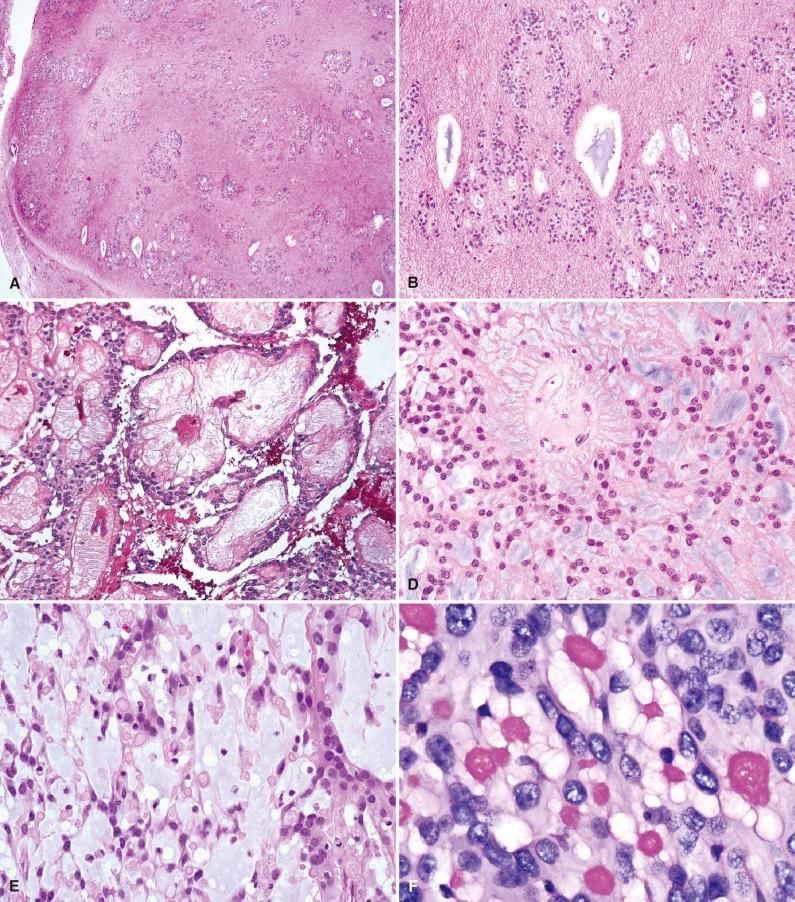
Myxopapillary ependymomas (MPE) characteristically show a variably papillary architecture with central blood vessels, surrounded by cuboidal to spindled glial cells radially arranged around an intermediate layer of Alcian blue–positive myxoid stroma (see Fig. 8.2C ). Some lesions exhibit a more compact fascicular pattern with intermixed mucin-rich microcysts and occasional perivascular pseudorosettes ( Fig. 8.2D ). Degenerative changes, including vascular hyalinization, are often prominent and may occasionally mask the more typical myxoid nature of this lesion. Some cases also feature rounded to spiculated collagen “balloons” that may be highlighted with trichrome, reticulin, and periodic acid–Schiff (PAS) stains ( Fig. 8.2E and F ). Despite the name, papillary growth pattern can be fairly inconspicuous in some myxopapillary ependymomas; nevertheless, the distinctive perivascular hyalinization and mucoid degeneration are typically found. Mitotic figures are uncommon, with necrosis and endothelial proliferation usually being absent. Rare anaplastic and giant cell variants have been described in case reports. Cytologic preparations typically recapitulate the histologic findings noted earlier, containing metachromatic material, bland nuclear morphology, and often papillary formations.
Ependymomas classically manifest as moderately cellular glial tumors showing sharp demarcation from the surrounding brain parenchyma ( Fig. 8.3A ) The cytologic characteristics of the tumor cells vary considerably, some displaying glial properties with elongated fibrillary processes, while others display epithelioid features reminiscent of non-neoplastic ependymocytes lining the ventricular surfaces. Key architectural features include a solid (i.e., noninfiltrative) growth pattern, perivascular pseudorosettes (anuclear zones formed by the processes of tumor cells radially arranged around blood vessels) ( Fig. 8.3B ), and true ependymal rosettes and canals. The latter consist of cuboidal to columnar tumor cells surrounding a central rounded (rosette) or elongate (canal) lumen ( Fig. 8.3C ). Although more specific for ependymoma than the perivascular pseudorosettes, true rosettes and canals are seen in only a minority of cases (5% to 10%). Mitotic activity is low (<5/10 HPF) and both palisading necrosis and microvascular proliferation are absent in these grade II tumors. However, geographic infarct-like zones of necrosis are relatively common and do not influence the prognosis. Pleomorphic nuclei may be present, but this feature alone does not justify a higher grade designation. Degenerative changes may also include hemorrhage, calcification, myxoid degeneration, and vascular hyalinization. Cartilage, bone, lipoma-like features (from fat accumulation), neuropil-like islands, and cells with melanin, signet ring, oncocytic, granular cell, giant cell morphology, or eosinophilic intracytoplasmic inclusions have all been described. Cytologic preparations of ependymomas typically contain cohesive clusters of cells with epithelioid to fibrillar cytoplasm and containing bland oval to rounded nuclei. Perivascular pseudorosettes and, rarely, true rosettes may be seen ( Fig. 8.3D ).
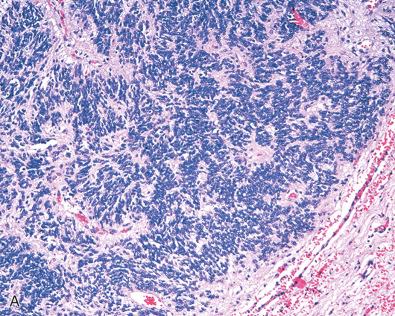
Cellularity of ependymomas varies greatly from case to case and even regions within the same case. Markedly hypercellular examples that lack microvascular proliferation, palisading necrosis, or an elevated mitotic rate have been previously designated as “cellular ependymoma,” but this is no longer considered a true variant in the latest WHO classification, as there is extensive overlap with otherwise conventional ependymomas as previously described. Perivascular pseudorosettes are typically well formed at least focally, but true rosettes and canals are generally lacking in these hypercellular ependymomas, which may mimic medulloblastoma or other embryonal neoplasms at lower magnification ( Fig. 8.4A and B ).
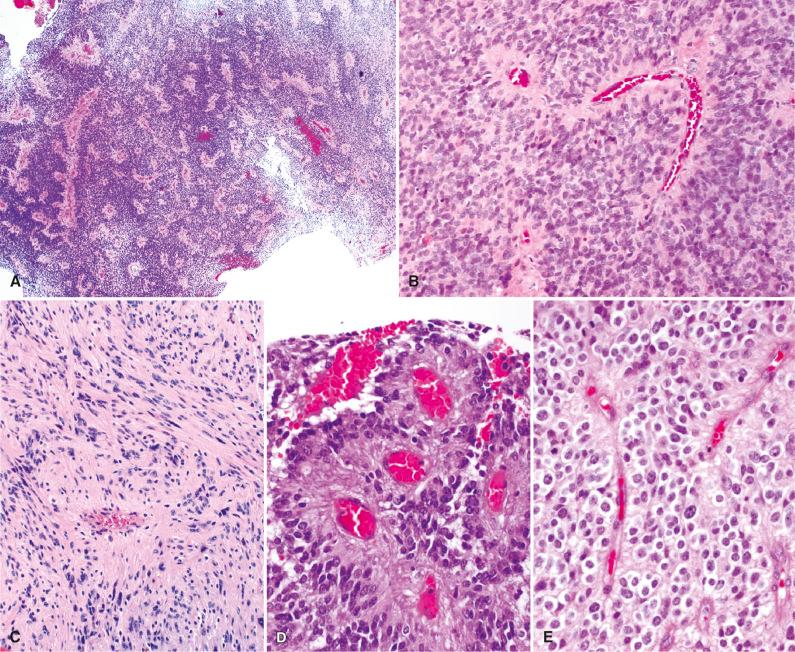
The following variants of conventional WHO grade II ependymoma have been well characterized:
Tanycytic Ependymoma. This variant has a particular predilection for the spinal cord, where the differential diagnosis is aided by the fact that radiologic features are similar to conventional spinal ependymomas. Typified by elongated spindled bipolar cells possessing thin eosinophilic fibrillary processes, it has been theorized that this variant most closely resembles the primitive radial glia-like tanycytes. With a predominantly fascicular architecture, only focal perivascular pseudorosettes, and lack of true ependymal rosettes, tanycytic ependymoma may resemble a variety of other nervous system tumors (particularly pilocytic astrocytoma and schwannoma ), thus providing a formidable diagnostic challenge ( Fig. 8.4C ). Nuclear pleomorphism may be prominent in some cases, though this clearly represents a degenerative feature given the generally innocuous biologic behavior exhibited by these tumors. Cytologic smear preparations may be similarly confusing, harboring cells with long, thin processes and oval to spindle-shaped nuclei closely resembling pilocytic astrocytoma. Ancillary testing is frequently needed to accurately classify this uncommon ependymoma.
Papillary Ependymoma. This uncommon ependymoma variant is characterized by single or multiple layers of cuboidal to columnar cells resting on central finger-like projections of gliofibrillary “stroma” ( Fig. 8.4D ); fibrovascular cores are not a feature, and the epithelial-like surfaces tend to be smooth in contour. In many cases, the architecture is more “pseudopapillary,” resulting from loss of cellular cohesion except immediately adjacent to blood vessels. Smear preparations likewise tend to have an epithelioid quality.
Clear Cell Ependymoma. Preferentially arising in a supratentorial location in pediatric and young adult patients, clear cell ependymoma contains sheets of cells with rounded nuclei and abundant surrounding clear cytoplasm mimicking oligodendroglioma, but with a discrete margin in relation to adjacent brain. The presence of thin, branching “chicken-wire” capillaries may add to this diagnostic challenge. Perivascular pseudorosettes may be subtle, but are invariably present, whereas true rosettes are absent (see Fig. 8.4E ). Unlike the aforementioned ependymoma variants, a significant proportion of clear cell ependymomas exhibit biologically aggressive behavior as well as histologic features of anaplasia (including endothelial proliferation, hypercellularity, and frequent mitoses), necessitating a WHO grade III designation. Additionally, this subtype will frequently be classified as the RELA fusion molecular variant based on further testing (see discussion in later section). Both clear cell and papillary variants may be intermixed with foci of otherwise conventional or anaplastic ependymomas.
The histologic grading of ependymoma and what role such grading plays in clinical prognostication remain a contentious issue. In addition to the histologic features of conventional grade II ependymomas (circumscription, perivascular pseudorosettes, ependymal rosettes), the WHO 2016 puts forth high nuclear-to-cytoplasmic ratio and high mitotic count (e.g., >5/10 HPF or >10/10 HPF depending on series) as essential diagnostic features of anaplastic ependymoma. These features are often accompanied by hypercellularity, as well as widespread microvascular proliferation and/or necrosis of the palisading type ( Fig. 8.5A–C ). Although several large series utilized more specifically defined histologic criteria to define anaplasia in ependymomas, correlations between grade and prognosis remain tenuous at best. Compounding this issue of grading is the fact that in a sizable subset of ependymomas, one finds few to multiple small areas of hypercellularity containing numerous mitotic figures, sometimes with accompanying proliferative vasculature. The threshold at which these zones of “focal anaplasia” become sufficient for WHO grade III designation has yet to be determined. Pleomorphic nuclei ( Fig. 8.5D ) may or may not be present; however, by definition, primitive or embryonal elements, with or without Homer Wright or ependymoblastic rosettes should not be present. Although all ependymomas display a predominantly solid growth pattern, foci of microinvasion into the adjacent brain parenchyma are more common in the anaplastic ependymomas ( Fig. 8.5E ). Given the inherent subjectivity of ependymoma grading noted, it is likely that molecular subgrouping of ependymomas will soon supplant histologic grading in providing relevant data for appropriate patient prognostication and treatment planning.
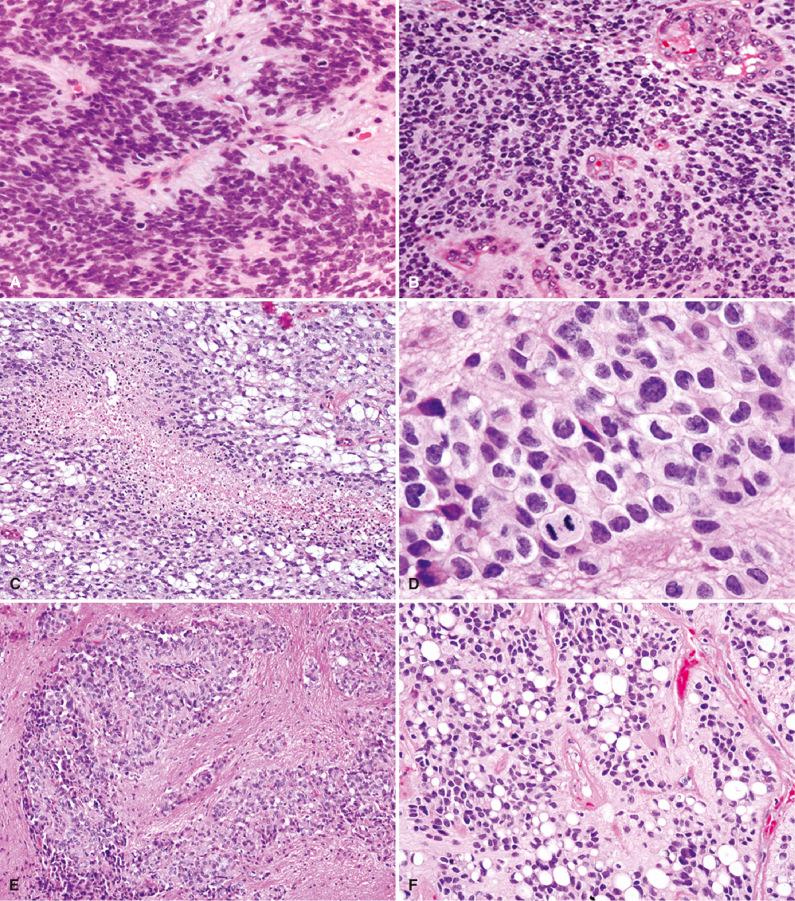
Become a Clinical Tree membership for Full access and enjoy Unlimited articles
If you are a member. Log in here